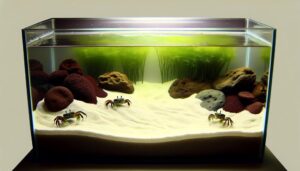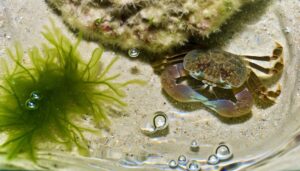How Do Fiddler Crabs Need Salt Water for a Perfect Habitat?
Fiddler crabs require access to both land and water for their survival and ecological functionality. These crabs inhabit intertidal zones leveraging both terrestrial and aquatic environments to fulfill their physiological needs.
They exhibit terrestrial feeding behaviors, constructing burrows on land for thermoregulation, predator avoidance, and reproduction. Water is essential for osmoregulation and larval release.
Burrowing in land substrates plays a critical role in maintaining moisture and oxygen levels. Their dual habitat preference, regulated by tidal rhythms, underscores the necessity of land for feeding, molting, and mating.
To understand the intricate balance of their habitat needs, further exploration is warranted.

Key Takeaways
- Fiddler crabs depend on terrestrial zones for feeding, mating, and burrow construction.
- Land access is crucial for their successful reproduction and molting cycles.
- Terrestrial habitats provide essential conditions for burrow construction and protective nurseries.
- Fiddler crabs utilize land for thermoregulation and predator avoidance.
- Land activities support their physiological processes, including osmoregulation and nutrient acquisition.
Fiddler Crab Habitats
Fiddler crab habitats are mainly located in intertidal zones, where they thrive in the dynamic interface between marine and terrestrial ecosystems. These zones are characterized by fluctuating environmental conditions, including tidal inundation and exposure, which create a unique ecological niche.
Fiddler crabs (Uca spp.) are highly adapted to these habitats, exhibiting behaviors such as burrowing and sediment manipulation to optimize their survival and reproductive success. Their burrows provide refuge from predators and extreme temperatures, and also facilitate gas exchange and sediment aeration. The presence of organic matter and detritus in these areas supports their detritivorous diet.
Additionally, the salinity gradients and tidal rhythms in intertidal zones are essential for their physiological processes, including osmoregulation and reproduction.
Land Versus Water
The habitat preferences of fiddler crabs necessitate a delicate balance between terrestrial and aquatic environments. Their breeding and molting cycles are inherently tied to the tidal rhythms, requiring access to both land and water.
Additionally, their terrestrial feeding behavior, characterized by foraging for detritus and microbial biofilms, underscores the importance of a dual-habitat system.
Habitat Preference Balance
Balancing their time between terrestrial and aquatic environments, Uca species exhibit a dual habitat preference that is essential for their survival and reproductive success. This balance is driven by physiological and ecological needs, necessitating periodic excursions onto land for activities such as foraging and predator avoidance, while depending on aquatic zones for hydration and waste excretion.
Research has identified several critical factors influencing this habitat preference balance:
- Osmoregulation: Maintaining internal salt and water balance.
- Thermoregulation: Avoiding thermal extremes by moving between land and water.
- Foraging: Access to diverse food sources in both environments.
- Predation: Seeking refuge from predators by utilizing both habitats.
- Energy Expenditure: Optimizing energy use by alternating between habitats based on activity.
These elements underscore the complex interplay between land and water in Uca species' ecological strategy.
Breeding and Molting Needs
Uca species display distinct habitat preferences during breeding and molting cycles, driven by the need for ideal environmental conditions to guarantee successful reproduction and exoskeleton regeneration.
During breeding, terrestrial environments are vital for constructing burrows, which serve as mating sites and protective nurseries for developing eggs. These burrows provide optimum humidity and temperature conditions, vital for embryogenesis.
Molting, a critical phase where crabs shed their exoskeleton to grow, also requires specific environmental parameters. The semi-terrestrial habitats offer a controlled environment that minimizes predation risks and ensures the necessary moisture levels to facilitate the hardening of the new exoskeleton.
Thus, both breeding and molting processes highlight the importance of land access for the survival and proliferation of Uca species.
Terrestrial Feeding Behavior
Terrestrial feeding behavior in fiddler crabs presents a unique adaptation, whereby different species exhibit varied preferences for foraging on land versus in aquatic environments, driven by the availability of organic matter and microalgae. This behavior is essential for nutrient acquisition and energy balance.
Research has shown that:
- Uca pugnax prefers foraging in intertidal zones rich in benthic microalgae.
- Uca vocans primarily exploits detritus and organic material found on the sediment surface.
Terrestrial foraging reduces predation risk compared to aquatic environments. The morphology of feeding appendages is adapted for sifting through sediment on land. Seasonal variations significantly influence the terrestrial versus aquatic foraging dichotomy.
Understanding these differential feeding behaviors is important for comprehending the ecological roles and habitat requirements of various fiddler crab species.
Burrowing Behavior
Fiddler crabs exhibit specialized burrowing behavior that serves multiple ecological and physiological functions. The primary purpose of their burrows includes protection from predators, thermoregulation, and desiccation prevention.
Additionally, their environmental preferences for burrowing are influenced by substrate composition, moisture levels, and tidal patterns.
Purpose of Burrows
Burrows constructed by fiddler crabs serve multifaceted functions. These include thermoregulation, predator avoidance, and reproductive activities. These subterranean structures are essential for maintaining ideal body temperature, providing shelter from predators, and facilitating mating rituals.
The burrows, which can vary significantly in depth and complexity, contribute to the ecological balance of their habitats.
- Thermoregulation: Burrows help in maintaining a stable internal temperature, vital for metabolic processes.
- Predator Avoidance: The subterranean refuge offers protection against both aquatic and terrestrial predators.
- Reproductive Activities: Males often use burrows to attract females for mating.
- Oxygen Regulation: Burrows assist in accessing oxygenated water during low tide.
- Moisture Retention: They help crabs retain moisture, preventing desiccation.
This adaptive behavior underscores the importance of understanding their habitat requirements.
Environmental Preferences
In examining the burrowing behavior of fiddler crabs, it is evident that these crustaceans exhibit a marked preference for intertidal zones characterized by fine sediment and moderate moisture levels. Their burrowing activity is influenced by sediment composition, moisture content, and tidal cycles. These factors provide ideal conditions for burrow stability and ease of excavation. Research indicates that fiddler crabs utilize burrows for thermoregulation, predator avoidance, and reproductive purposes. Below is a table summarizing key environmental preferences and their corresponding effects on burrowing behavior.
| Environmental Factor | Ideal Condition | Effect on Burrowing Behavior |
|---|---|---|
| Sediment Type | Fine Grain | Enhanced burrow stability |
| Moisture Level | Moderate | Optimum for burrow construction |
| Tidal Influence | Intertidal Zones | Periodic exposure and submersion |
| Temperature | Warm | Increased metabolic activity |
| Predator Presence | Low | Reduced burrow abandonment |
Breathing Mechanisms
Utilizing a combination of gills and modified air-breathing structures, fiddler crabs have evolved unique respiratory adaptations to thrive in their intertidal habitats. These crabs possess gills for aquatic respiration and specialized branchiostegal lungs for aerial respiration, enabling survival in both submerged and terrestrial environments.
The gills efficiently extract oxygen from water, while the branchiostegal lungs facilitate gas exchange when exposed to air. This dual system is essential for their mobility between aquatic and terrestrial zones.
Key features include:
- Gill morphology: Adapted to extract oxygen from water.
- Branchiostegal lungs: Allow respiration in air.
- Oxygen retention: Ability to store oxygen for terrestrial periods.
- Behavioral adaptation: Movement between water and land to optimize respiration.
- Moisture maintenance: Essential for gill function when out of water.
Feeding Habits
Fiddler crabs exhibit a diverse array of feeding strategies, primarily engaging in deposit feeding and detritivory to extract organic matter from sediment. These crustaceans use their specialized mouthparts, including the maxillipeds and mandibles, to sift through substrate particles, selectively ingesting nutritive components.
Research highlights their ability to digest diatoms, bacteria, and microalgae, which are abundant in intertidal zones. Fiddler crabs also display temporal feeding patterns, with peak activity often coinciding with low tide, optimizing resource availability.
Studies have shown that their feeding efficiency is influenced by sediment grain size and organic content. This intricate feeding behavior is essential for their survival, contributing to nutrient cycling within their ecosystems and maintaining the health of coastal habitats.
Reproduction Needs
Reproductive success in fiddler crabs is primarily driven by the availability of suitable burrowing sites, which provide essential protection for mating activities and the incubation of eggs. These burrows serve as a refuge from predators and environmental stressors, ensuring the safety of both adults and developing offspring.
Key factors influencing reproductive needs include:
- Burrow architecture: Depth and complexity affect temperature and humidity regulation.
- Sediment composition: Ideal grain size is critical for burrow stability.
- Tidal influence: Synchronization with tidal cycles facilitates larval release.
- Male signaling: Enhanced by prominent burrow entrances to attract females.
- Predator avoidance: Burrows reduce predation risk during vulnerable mating and brooding periods.
Understanding these factors is crucial for conserving fiddler crab populations and their habitats.
Environmental Adaptations
Adaptations to fluctuating environmental conditions are essential for the survival and thriving of fiddler crab populations in their intertidal habitats. These crabs exhibit remarkable physiological and behavioral adaptations to cope with varying salinity, temperature, and oxygen levels.
For instance, they possess specialized gill structures enabling efficient osmoregulation, vital for maintaining ionic balance in brackish water environments. Additionally, fiddler crabs demonstrate burrowing behavior, which serves as a refuge against extreme temperatures and predators. Their burrows also facilitate gas exchange, mitigating hypoxic conditions during high tide submergence.
Besides, the rhythmic activity patterns synchronized with tidal cycles optimize feeding and mating opportunities while minimizing desiccation risks. Collectively, these adaptations underscore the ecological resilience of fiddler crabs in dynamic coastal ecosystems.
Importance of Land
Terrestrial zones play an essential role in the life cycle of fiddler crabs, providing indispensable resources for feeding, mating, and burrow construction. These crabs exhibit a strong dependency on land for various biological and ecological functions. Research highlights the significance of intertidal areas where fiddler crabs interact with their environment to meet physiological and reproductive needs.
Key activities conducted on land include:
- Feeding: Scavenging for detritus and microorganisms.
- Mating: Courtship and mating rituals requiring dry surfaces.
- Burrow Construction: Creating and maintaining burrows for shelter and reproduction.
- Thermoregulation: Regulating body temperature away from water.
- Predation Avoidance: Seeking refuge from aquatic predators.
Understanding the terrestrial requirements of fiddler crabs is vital for conservation efforts and habitat management.
Conclusion
In summation, Uca spp. exhibit a critical reliance on terrestrial environments for various biological functions, including burrowing behavior, feeding mechanisms, and reproductive activities.
The dichotomy between aquatic and terrestrial habitats underscores their amphibious nature, necessitating both environments for best survival.
Adaptations such as specialized gill chambers facilitate respiration in both media.
Consequently, the ecological niche of fiddler crabs is intricately linked to the availability of land, underscoring its paramount importance for sustaining their populations.






